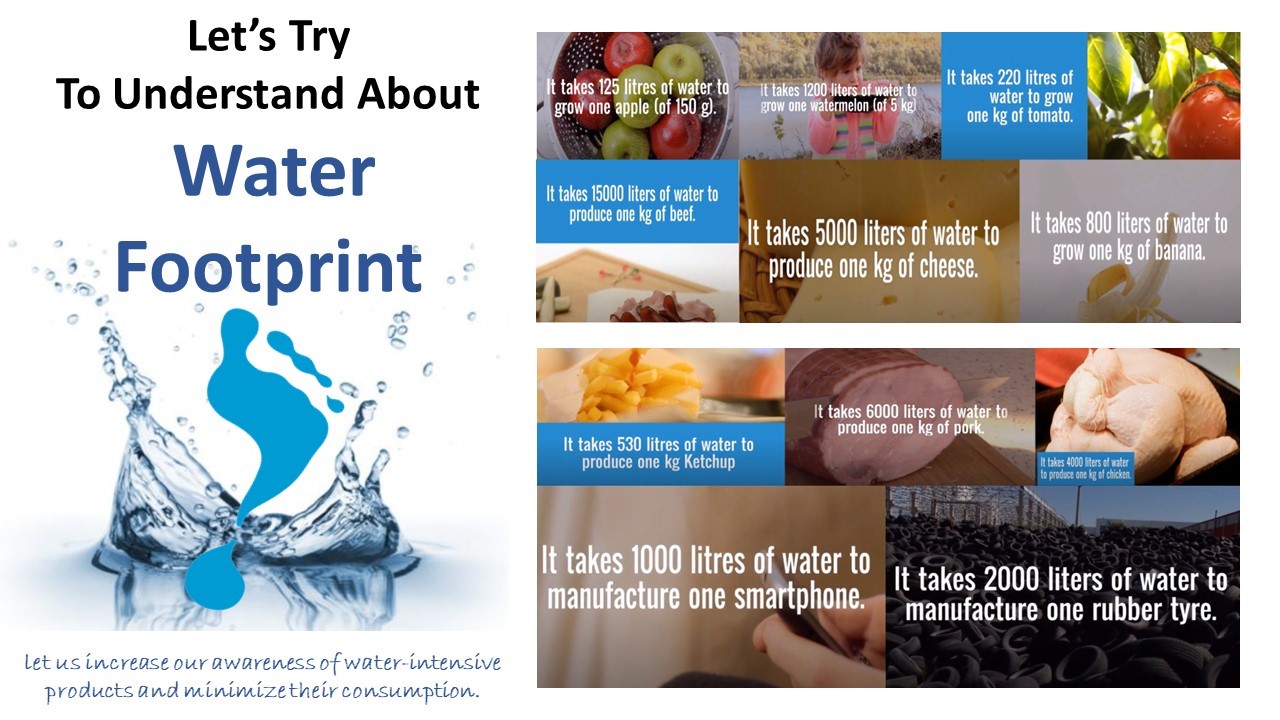Let’s Try To Understand About Water Footprint

Let’s Try To Understand About Water Footprint
Date: 20 May 2022
Author: Mr. Naveen Kumar
Background
Water is vital for life. Clean freshwater is necessary for drinking and sanitation purposes and for our crops, livestock, industry, and for creating and sustaining the ecosystems on which all life depends. However, readily accessible freshwater is found in rivers, lakes, wetlands, and groundwater which accounts for less than 1% of the world’s total water. As the worldwide, population is growing, so too do the demand for water is also increasing, which is important for agriculture, food production, product manufacturing, industrial activities, and also our daily activities. At the same time, anthropogenic and climate change are disrupting natural water cycles, putting freshwater ecosystems under pressure. Pollution, infrastructure development, and resource extraction pose additional challenges.
Therefore, it is important that we all must know about our water footprint, and this is our duty to also aware people and reduced our water footprint as much as we can.
The economist said that water will be the oil in the twenty-first century. Water, like oil, is a finite resource; yet, unlike oil, there is no substitute for water. If not the most valuable resource, we have one, but it is not given the respect, admiration, or protection it deserves.
Water (Chemical formula H2O)
Water is an inorganic, transparent, tasteless, odorless, and almost colorless chemical substance that is the primary constituent of the Earth's aquatic environment and all known living organisms' fluids Even though it contains no calories or organic nutrients, it is necessary for all known forms of life.
What is a water footprint?
Everything we use, wear, buy, sell and eat takes water to make. The water footprint is the way of measuring of water you use in and around home, office, and school during the day. It also includes the water you use directly and indirectly. The water footprint appears in both direct and indirect water use of a process, product, company, or sector and includes water consumption and pollution throughout the full production cycle from the supply chain to the end-user. The Concept of water footprint was introduced in 2002 by Arjen Y. Hoekstra.
It is also possible to use the water footprint to measure the volume of water essential to produce all the goods and facilities consumed by the individual or community, a country, or all of humankind. it also includes the direct water footprint, which is the water used directly by the individual(s), and the indirect water footprint – the summary of the water footprints of all the products consumed.
Types of water footprint
Water footprint has three components blue, green, and gray. All these three show comprehensive figures of water use by delineating the source of water consumed, either as rainfall/soil moisture or surface/groundwater, and the volume of freshwater required for assimilation of pollutants.
BLUEWATER FOOTPRINT: It is defined as the use of water that originates in sources such as surface and ground.
GREEN WATER FOOTPRINT: It is defined as the use of water that originates in sources such as rainwater stored in the soil as soil moisture.
GRAY WATER FOOTPRINT: It is defined as the amount of water required to maintain water quality and adjust the pollutant.
Water footprint Country Wise
Globally 25% of the population lives in extreme water stress. Additionally, over one billion individuals live in ranges where water is rare. Without serious action, this figure is expected to rise to 3.5 billion by 2025. In spite of the fact that our worldwide water footprint level is beyond sustainability, variety does exist between countries. A study estimated various National water footprints on annual basis in 2011.
- China: 1.5 billion people use 362 trillion gallons
- United States: 300 million people use 216 trillion gallons
- Brazil: 175 million people use 95 trillion gallons
- Russia: 143 million people use 71 trillion gallons
- Mexico: 100 million people use 53 trillion gallons
- India: 1.1 billion people use 30 trillion gallons
- England: 60 million people use 20 trillion gallons
- France: 60 million people use 20 trillion gallons
- Canada: 33 million people use 19 trillion gallons
- Australia: 20 million people use 12 trillion gallons
How You Can Minimize water footprint
Let us increase our awareness of water-intensive products and minimize their consumption by adopting following practices-
· Turning off the tap while brushing your teeth.
· Using water-saving toilets.
· Installing a water-saving shower head.
· Taking shorter showers.
· Only washing your clothes when necessary.
· Fixing household leaks.
· Using less water in the garden and when cleaning.
· Not disposing of medicines, paints or other pollutants down the sink.
· Eating less meat. Beef is one of the most water-intensive proteins, needing 15,000 litres of water per kg, followed by red meats in general. Other, less water-intensive proteins include pulses like beans, lentils and peas.
· Switching coffee for tea. Cups of tea and coffee may look like they contain the same amounts of liquid, but producing coffee beans requires far more water than growing tea leaves.
· Cutting down on sugar. Drinking a bottle of cola actually consumes around two or three bathtubs full of water.
· Eating less processed food. Water is required at every stage of food production – refining, processing, canning, packaging.
· Consuming more local produce. Producing a tank of petrol requires a lot of water, so reducing the amount of miles you food has to cover from farm to plate will also help save.
· Buying quality, not quantity. The clothes we wear use huge amounts of freshwater.
“Every drop we save is precious!”
Edited By: Dr. Anchal Garg
hdyu5vvvkq|10001522Por_Blogs|Contentdb